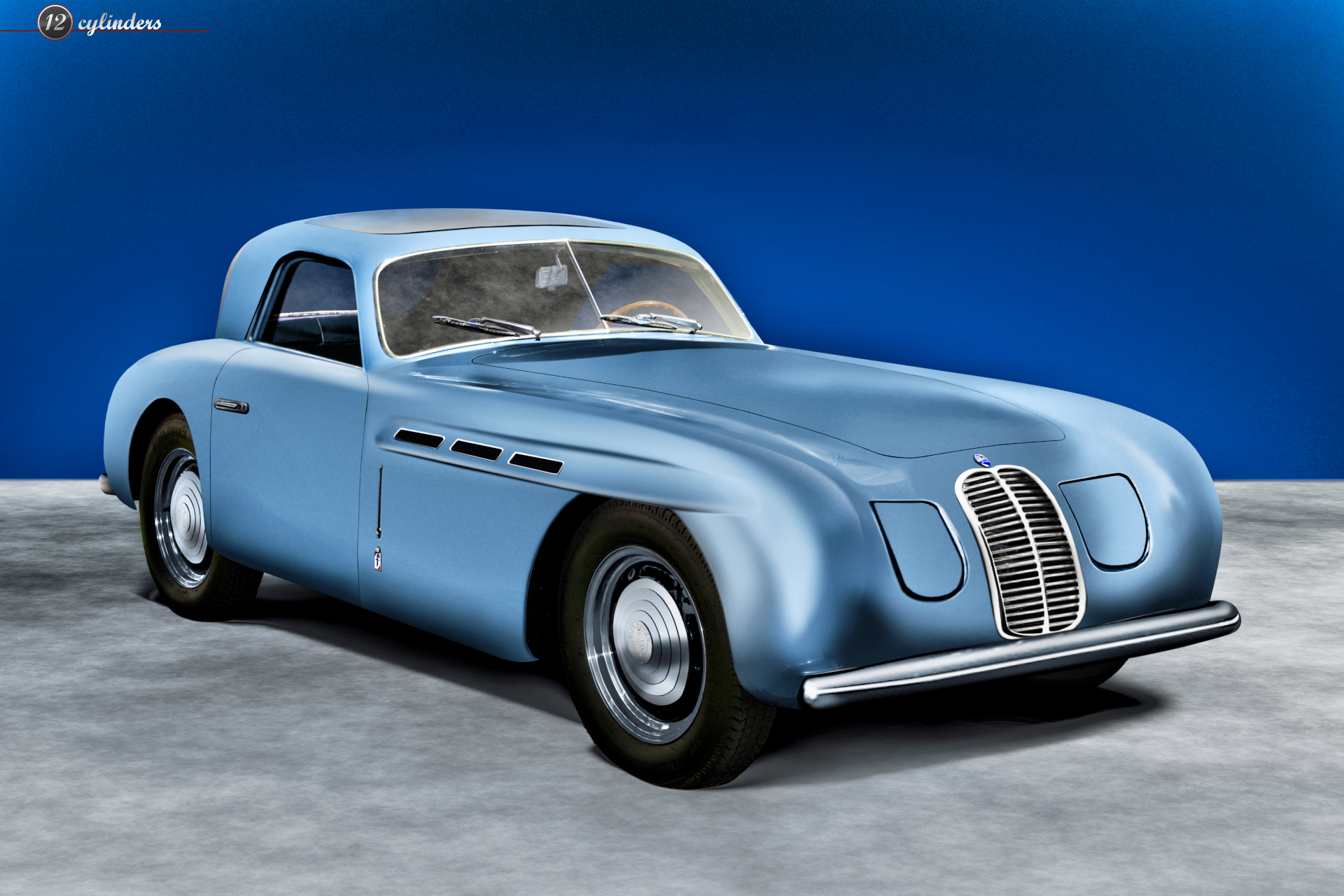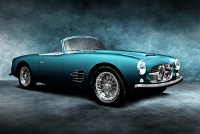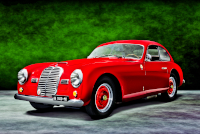Prologue:
Maserati adherents are quick to note that Pinin Farina conceive of the A6 before Piero Dusio brought Cisitalia into existence. So in terms of precedent—in terms of the reasons the MoMa acquire a Cisitalia 202 to represent the modern art form on four wheels—the genesis of the concept could very well wear a Maserati badge.
In practice, however, the concept is Pinin Farina's, born from pre-War thinking about aerodynamics and design trends already in evidence a decade prior. And so the marque does not matter quite so much. Only that we lost the A6 show prototype does history inhibit a common understanding of Maserati's role in modern car development.
At some later stage, I'll need to illustrate the tail quarter perspective, whereas at the moment I don't have the stock on which to base another image. And perhaps a few details could tighten this interpretation. As it stands, the car is a beautiful design exercise from that most interesting post-War transitional era, and represents the start of something quite significant in the design world at large. We need this interstitial profile to tie the two eras together, to say nothing of the enjoyment in bringing a lost design back to life.
- - - - - - - - - -
► Image Source: Nikon D750 (24.3 MP)
References:
- Cancellieri, Gianni; Dal Monte, Luca; De Agostini, Cesare; Ramaciotti, Lorenzo. (English translation by Neil Davenport and Robert Newman.) "Maserati, A Century of History: The Official Book" Giorgio Nada Editore, Vimodrone, Milano, Italia. 2013, page 104-111
- Carrozzieri Italiani: Context for chassis #051 presented in the description of the second prototype, chassis #053, a similar, yet more conventional design.
Pinin Farina claim a significant role in postmodern design evolution. At least we believe so ever since the MoMa added the Cisitalia 202 to their collection in 1972. Also penned by Pinin Farina, the Maserati A6 is older in its engineering development and certainly a hair's breadth rarer. And in any case the very first prototype illustrated here no longer exists, whereas the second car (#053) never leaves Italy. So where should the New York museum turn to illustrate this modern arts movement other than a sister of the same design house?
To be equitable, the marque matters less than the design plan, which the Cisitalia demonstrates in its most marketable form in period. And by the time of its production in 1947, the Maserati A6 1500 looks much like the Cisitalia 202.
Contrarily, the first prototype avoids classical shape and goes a bit farther down the postmodern avenue, particularly in its use of recessed headlamps and a truncated cabin that approximates a three-box architecture style that becomes vogue roughly 15 years later. This design thinking is advanced for 1947, yet Pinin Farina pull back to a more classically pleasing shape for the production A6, which is a simple variant of the Cisitalia.
So, to revisit Anselmi's words, "More significant than the Cisitalia 202 for the future of the Italian GT," the truth is that both exercises represent a common design language penned by the same author, and their historical value is rather equal in this regard. Variations may relate to later design in different degrees, but these differences are part of the broader evolution. They are not a function of revisiting one seminal design and adjusting a curve or a window. And furthermore these evolutionary designs simply cannot be so narrowly explained because the aerodynamic design trend on which they are based began much earlier in the classic era.
1947 and the Maserati Turning Point
In 1947, the Maserati brothers' ten-year contract with owner Adolfo Orsi comes to an end. Their arrangement has been rewarding. Orsi gradually builds Maserati into a stable business while the brothers focus on their hearts' desire without the stress of business management.
All matters seem laid out on the table for the brothers to remain at Maserati. But, as Luca Dal Monte notes, "The Maserati brothers evaluate the situation carefully. In the end, the yearning to return home wins the day. Over the previous ten years they had continued to live in Bologna, commuting to Modena and back each day by train or even bicycle."
This amicable division gives birth to O.S.C.A., a sports car marque very much in the spirit of the A6. So it is that the A6 is the gift the brothers leave their namesake firm; it is their final Maserati project. Named for Alfieri, Dal Monte notes, "the choice of a Maserati's initial just before the brothers left the company says a lot for the atmosphere that existed during the ten years in which the Bolognese and Modenese companies coexisted as part of the same group." That is, they are of one mind, driven toward common goals with the utmost respect for family and the origin of a name that means so much to Italy.
As for this car, the A6 engineers are Ernesto Maserati, who in 1932 assumed chief duties after Alfieri's passing, and Alberto Massimino. Along with Vittorio Bellentani, Massimino will further the brothers' ethos like an acolyte of a painting school as Maserati develops racing and road cars under Orsi's direction.
But for this moment, the A6 demonstrates an idea that has percolated since the 1930s, an awareness that a roadable sports car with a Maserati badge would establish the marque as an automaker of distinction. The means were never available for want of racing, but design sketches and a few classic era road cars prove that the desire pre-dates Orsi's involvement.
This post-War product, completed in February of 1947, debuts in March at the Geneva Motor Show. If we can distinguish the A6 1500 prototype from the Cisitalia 202, it is that the A6 is an ideas car whereas the 202 is a production exercise. In no small way, Pinin Farina's later refinement of the A6 to a shape derived from the Cisitalia underscores this difference, and the decision to temper the car's individuality may be wholly practical in terms of limiting production costs.
So this is the turning point: Ernesto, Ettore, and Bindo leave Maserati to found O.S.C.A. just as the A6 takes shape. But this gift ensures that Maserati take the correct trajectory into the post-War era, and that they become a marque of true distinction.
Motor: 1,488 cc straight 6-cylinder, alloy block and head | 66 mm x 72.5 mm | 7.25:1 compression
Ernesto Maserati and Alberto Massimo develop the 1.5-litre unit early in the post-War era. This motor appears to be a derivation of the 1,493 cc from the 6CM that dates to the classic era. Crump and de la Rive Box write that, "This model earned the factory a tremendous reputation during 1936 and 1937, at a time when it was much needed." So the 1.5 litre motor is perhaps both a rational and economical starting point for post-War development.
Valvetrain: SOHC, 2 valves per cylinder
Aspiration: single Weber 36 DCR carburetor
Power: 65 bhp at 4,700 rpm
Drivetrain: 4-speed gearbox, rear-wheel drive
Front Suspension: independent double wishbones with coil springs, Houdaille dampers
Rear Suspension: live axle with semi-elliptic leaf springs, Houdaille dampers
Architecture: steel tubular frame with longitudinal and cross members, aluminum body by Pinin Farina of Torino
Wheelbase: 2,550 mm (100.39 inches)
Etymology:
The all-important 'A' memorializes Alfieri, founder and spiritual leader among those four mechanically inclined brothers (of seven) who venture into racing car development. '1500' denotes the motor capacity, derived from the firm's success in voiturette racing during the classic era.
When the A6 1500 matures into production form, Maserati's terminology uses the French 'Turismo Coupé' nomenclature, whereas the car is a berlinetta in the Italian vernacular. As Maserati opt for the French term, I follow suit.
Figures:
Maserati cite 61 total A6 1500 examples, of which five are prototypes and specials. This car, #051 is the first prototype, now lost to the ages. The closest cousin is #053, the soft bronze show car now in the Museo Nicolis collection in Verona.
Some sources suggest #051 and #053 came to completion in 1946, with some claims that #051 pre-dates the first Cisitalia 202. Maserati's official history places production of #051 at February, 1947. The discrepancy may be the difference between Maserati's build dates for the rolling chassis, as opposed to Pinin Farina's build dates for the completed car. In any case, the A6 concept dates back to the very beginning of the decade, and Pinin Farina's design is a concept unto itself, less a part of either Cisitalia or Maserati than a development of design theory already evident in the 1930s.
Ideas Car: The A6 1500 Prototipo in Relation to Cisitalia and Alfa Romeo
This term, an ideas car, means that Pinin Farina inject experimental concepts into the A6 1500 plan. In contrast, the Cisitalia 202 is a classical shape. The 202 is an integrated whole of gentle curves and pleasing proportions. The first A6, #051, is a showcase.
From the front, Farina recess the headlamps behind swivel doors, a feature that dates to the classic era but works exceptionally well with a smooth, fully integrated fascia. The front wings cut over the front wheels in hard, vertical fashion, an anachronistic trait in that all subsequent designs (whether Cisitalia or Maserati) use more conventional headlamp pods.
With the headlamps brought inboard, the grille is narrow. This feature tethers the A6 prototype to its Maserati racing kin. All later examples widen the grille, a horizontal approach similar to the Cisitalia design.
The cabin sits upright and houses intriguing trapezoidal windows. The aft bolsters are fully concealed C-pillars, not unlike Touring's early Alfa Romeo 6C 2500, except the shape tapers inward. Lorenzo Ramaciotti writes, "The greenhouse has a droplet shape, with no fear of the unusual proportions between metalwork and glazing and a small, compound-curving rear screen." This elongated cabin provides room for a 2+2 configuration, whereas that rear window is convex bubble. Pinin Farina will update this design on chassis #053, which replaces the blind C-pillars with glass and uses a more conventional flat plate back window.
Another feature of the cabin—one shared with the Alfa Romeo, particularly the 6C 2500 Aerlux—is the Plexiglas sunroof. This feature appears only on chassis #051.
Lastly, one particularly intriguing idea is the bidirectional bonnet. The bonnet tilts up sideways and sits on a centrally mounted pivot arm so that one can open it from either side. This feature survives on all of the A6 production cars.
Aerodynamic Brow: Post-War Pinin Farina and Alfa Romeo Origins
Only chassis #051 and #053 use a linear brow along the front quarters, both fitted with a set of three vents. In its Pinin Farina application, this design cue dates to 1945-46 on the Alfa Romeo 6C 2500 Sport Cabriolet, chassis #915169. Pinin Farina quickly dispose of this feature on the Maserati A6, which indicates a strong preference for cleanliness, where added body moulding may seem vestigial. The Cisitalia does without from the start, though some examples use ovoid vents, much in the style of Vignale.
That said, Carlo Felice Bianchi Anderloni is at the same time refining similar lines into linear components along the front arches. These design cues become part of the Touring Superleggera lexicon on post-War Alfa Romeo and Ferrari cars, which quickly translates up north to the Aston Martin DB2.
In Germany, the brow concept Pinin Farina demonstrates here on the A6 1500 translates to the Mercedes-Benz W196 and production 300SL, representing a tacked approach. Conversely, Albrecht von Goertz adopts Touring's sculpted appoach on his BMW 507.
Whether tacked or sculpted, the Italian styling houses develop a new lexicon that spreads throughout Europe. These concepts are not part of the Paul Jaray school, but new inspirations.
New Inspiration: Italy and the Postmodern Car
I suppose the best explanation is enthusiasm. Merely that the automobile is so important to Italy that, amid the debris of World War II, Italian industry blossoms with creative energy. At this point, France can only re-tell a story of classic era elegance, soon to fall under the guillotine of such heavy taxation so as to bury their very best. Germany suffer the effects of reconstruction and geopolitical division, many years from furthering similar innovations. And England are for the time being rather beholden to others for artistic inspiration of the automotive variety, if not content with their particular sense of austerity.
In Italy, however, ideas abound. And yet for all the sensation stirred up over new shapes, the platform represents a return to basics. The Maserati A6 and Cisitalia 202 use racing derived theory; they diminish front and rear overhangs in a tidy rebuke of classic era girth. In this respect, the platform is rather similar to the Alfa Romeo 6C 1750 with its wheels pressed to the corners, though the chassis is now underslung with a modern suspension.
So the Maserati A6 and Cisitalia 202 represent what Italy know how to do well—develop alluring small capacity sports-racing cars. The components have been available since the classic era, both in terms of pure ideas and experimental designs, but these early post-War prototypes stamp out the shape that will direct the automotive industry for the next 50 years.
Last Updated: May 19, 2025



